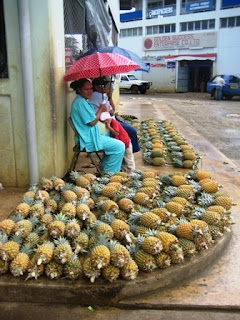Among the many aspects of my Peace Corps life I will miss after I return to the


I have developed a newfound appreciation for eating foods that are in season, recognizing how fresh fruits and vegetables are supposed to taste in their natural state. I have also recognized the financial benefit of buying fruits and vegetables that are in season. Throughout November and December you can buy up to five pineapples for $4 Tongan pa’anga (about $2 US). If I wanted to buy a pineapple before or after the season is in full swing, however, the cost can go up to $10 for one pineapple and the fruit is nowhere near as delicious.


The fair majority of people who sell their goods at the market come from my village. Everyone knows my name and asks with genuine interest how I am and what I am doing during my trips to the market. Many times have to force people to take my money for their goods and I almost always leave with a complimentary watermelon, head of cabbage, or a zucchini along with my other purchases.




Last year I realized how strikingly different shopping at a big grocery store is in comparison to what I’ve grown accustomed to over the past two years at the local market. Soon after my return home for the holidays last year, I naively offered to go grocery shopping for my mother to help with Christmas dinner preparations. As soon as those giant automatic doors slid open I realized I had made a horrible, horrible decision. I stood there frozen, taking in the sights and smells of “Super Stop and Shop” with a look of horror on my face. In one short year how could a place that had been so familiar become so completely foreign?




Initially the grocery list my mother had given me seemed simple enough; however, once I slowly started making my way through the many aisles of the enormous and very crowded store, each and every item presented a problem. Walnuts, apparently, come in several varieties: whole, halved, crushed, etc. While struggling to use a hanging scale to weigh five pounds of potatoes I had tirelessly placed in a green bag, my aunt and uncle auspiciously appeared and pointed out the location of the already bagged and weighed potatoes before I could make too much of an ass out of myself. Once out of the produce section I thought I was home free, but no such luck. My traumatic shopping experience culminated when I noticed that in place of the “cookie club” table I had frequented as a child stood a Starbuck’s kiosk. I knew it was time to go home.



Upon return to



1 comment:
Sarah,
Those are some fanastic pictures - I could go for a pineapple right now! I also enjoyed your grocery store story since I have one just like it from my return to the US from Ukraine. Best of luck with the last month or two of your service!
Shelley
Post a Comment